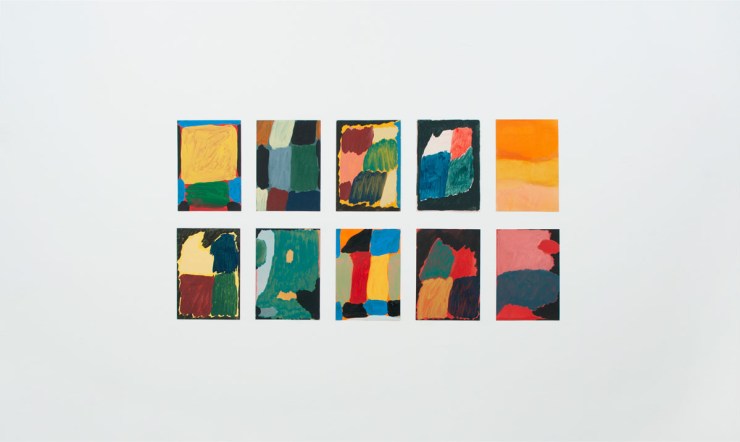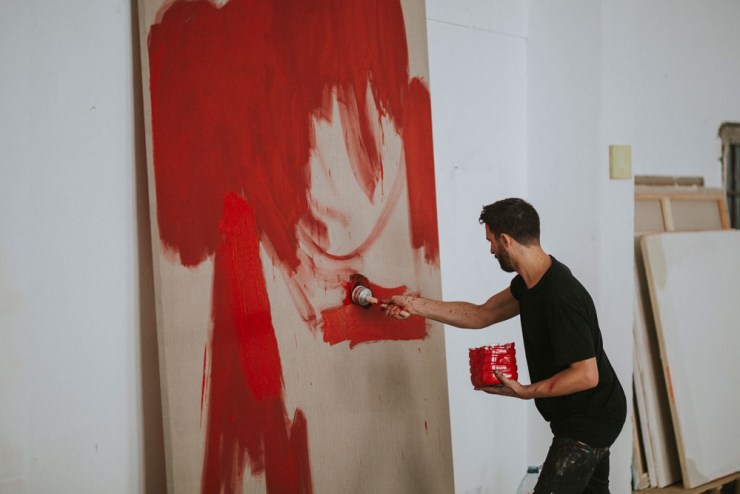
INTERVIEW:
NELO VINUESA
BY : ABSTRACT | AUGUST 26, 2020
We are glad to present a joint interview of Sam Trioli and Roman Sviridov in which they talked with Nelo Vinuesa, learning more about his early period, formation and a new series of works that is presented in an online show called CAVERN FIRE.
Join and share with your friends!
Join and share with your friends!
Sam Trioli: Take us back to the start of everything, how did you arrive at abstract painting?
Nelo Vinuesa: Since I was a fine arts student, I have felt connected to abstraction, especially American Expressionism and European Informalism. Masters such as De Kooning, Clifford Still, Arshile Gorky or others closest to me, such as Mirò, Tàpies, Miguel Angel Campano or José Guerrero among others, have decisively influenced my way of understanding painting. But I have also been inspired by audiovisual culture, video games or computer graphics, and in previous projects I have used the expressive potential of these references.
Roman Sviridov: I remember your old geometric works, they were urban reliefs and futurism. What has changed in your perception of those ideas since then?
NV: Since my beginnings I have been interested in using registers and structures of an opposite nature in my paintings. That is why in old works I have mixed figuration and abstraction or gesture and geometry. A few years ago I began to paint a series in which I used brushstrokes to compose landscapes and on these organic structures I overlapped geometric forms that gravitated evoquing architectures or constellations of symbols.
In a later series, I tried to isolate these elements to compose a kind of "Atlas" and I worked in a rigorous way only with geometry. Although my composing method is always dynamic, probably working in this way for a long period made me think that the working method should not be too restrictive, and the technique should not be excessively complex or mechanical, as not to limit my natural expression.
So, About four years ago I decided to close this stage and I started to explore the gestural part that was also present in my old works. Soon I discovered that my technique was freer and better adapted to my personality, which is why paintings gained in spontaneity and expressiveness.
Nelo Vinuesa: Since I was a fine arts student, I have felt connected to abstraction, especially American Expressionism and European Informalism. Masters such as De Kooning, Clifford Still, Arshile Gorky or others closest to me, such as Mirò, Tàpies, Miguel Angel Campano or José Guerrero among others, have decisively influenced my way of understanding painting. But I have also been inspired by audiovisual culture, video games or computer graphics, and in previous projects I have used the expressive potential of these references.
Roman Sviridov: I remember your old geometric works, they were urban reliefs and futurism. What has changed in your perception of those ideas since then?
NV: Since my beginnings I have been interested in using registers and structures of an opposite nature in my paintings. That is why in old works I have mixed figuration and abstraction or gesture and geometry. A few years ago I began to paint a series in which I used brushstrokes to compose landscapes and on these organic structures I overlapped geometric forms that gravitated evoquing architectures or constellations of symbols.
In a later series, I tried to isolate these elements to compose a kind of "Atlas" and I worked in a rigorous way only with geometry. Although my composing method is always dynamic, probably working in this way for a long period made me think that the working method should not be too restrictive, and the technique should not be excessively complex or mechanical, as not to limit my natural expression.
So, About four years ago I decided to close this stage and I started to explore the gestural part that was also present in my old works. Soon I discovered that my technique was freer and better adapted to my personality, which is why paintings gained in spontaneity and expressiveness.
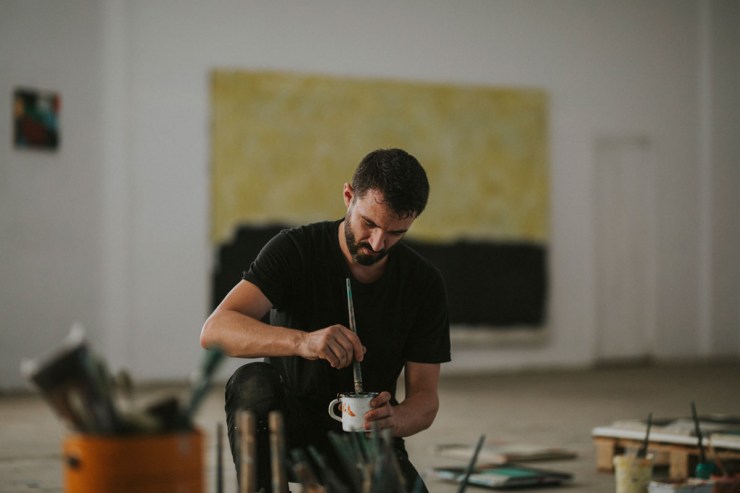
ST: What was the first painting you remember experiencing as a kid?
NV: My father painted as a hobby and I have wonderful memories of seeing him concentrated in a tiny room with his easel, oil colors and palette. I also had a big encyclopedia of art history at my family house and since childhood I was fascinated by the great masters. One day, when I was about ten years old, I went with my parents to the Museum of Fine Arts in Valencia and I remember, as if it were yesterday, that in the museum hall there were several monumental paintings by Muñoz De Grain, a 19th century Valencian painter. This image impressed me a lot, those mythological paintings were like huge windows to other worlds.
ST: What would you say your inspirational source is?
N.V: I think that our outlook is forged in childhood at different levels. I was born in the 80s, so my generation was the last to experience the end of the "off-line" era. I only say that because as any kid of my age I spent much time reading comics, playing arcade video games and also with blocks and building-toys, as well as watching cartoons… but I also enjoyed the countryside and to be in contact with nature. I had interest in the cosmos, science, and anything related to discovering and exploration, maybe for this reason the landscape idea has a big weight in my work. In a way, when I make art, I feel that I am doing a journey through my own experiences and memories.
NV: My father painted as a hobby and I have wonderful memories of seeing him concentrated in a tiny room with his easel, oil colors and palette. I also had a big encyclopedia of art history at my family house and since childhood I was fascinated by the great masters. One day, when I was about ten years old, I went with my parents to the Museum of Fine Arts in Valencia and I remember, as if it were yesterday, that in the museum hall there were several monumental paintings by Muñoz De Grain, a 19th century Valencian painter. This image impressed me a lot, those mythological paintings were like huge windows to other worlds.
ST: What would you say your inspirational source is?
N.V: I think that our outlook is forged in childhood at different levels. I was born in the 80s, so my generation was the last to experience the end of the "off-line" era. I only say that because as any kid of my age I spent much time reading comics, playing arcade video games and also with blocks and building-toys, as well as watching cartoons… but I also enjoyed the countryside and to be in contact with nature. I had interest in the cosmos, science, and anything related to discovering and exploration, maybe for this reason the landscape idea has a big weight in my work. In a way, when I make art, I feel that I am doing a journey through my own experiences and memories.
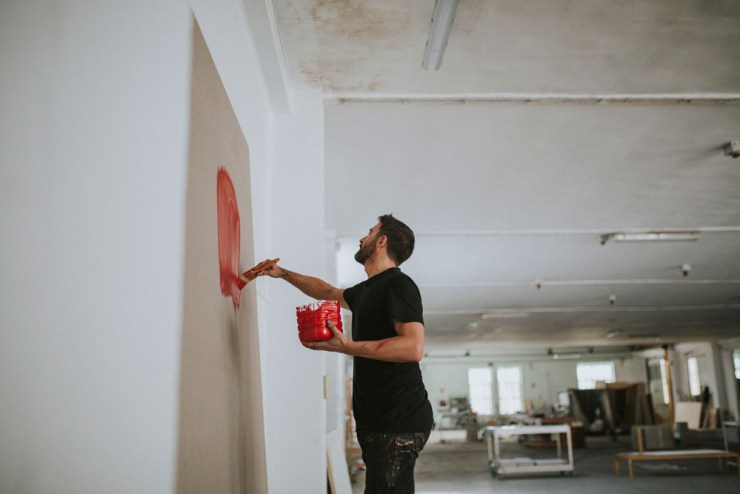
RS: In your opinion, does the new generation of the online era have more advantages? Or is that cozy childhood the best thing for a child?
NV: Every generation experiences advantages and disadvantages, but in my opinion, during childhood it is convenient to stimulate the physical and sensory relationship with our environment. I believe that living glued to a screen, far from amplifying, limits our experience and this for me is a serious problem. The Internet is an infinite source of knowledge and obviously allows us to establish wonderful connections between people, but I think it is important that there is a technological balance and this depends mainly on education.
RS: Do you often work on several paintings at the same time?
NV: Yeah, that's how I usually work. Some of my pieces are painted "alla prima" but most of my works need different layers and then you have to wait due to the drying time. Therefore, working on several pieces at the same time is a dynamic and fluid system. Moreover, the time intervals are perfect to reread the piece and transform the chromaticism or the composition if I consider it necessary. Sometimes I had complex pieces hidden for months until I found the best way to solve it.
NV: Every generation experiences advantages and disadvantages, but in my opinion, during childhood it is convenient to stimulate the physical and sensory relationship with our environment. I believe that living glued to a screen, far from amplifying, limits our experience and this for me is a serious problem. The Internet is an infinite source of knowledge and obviously allows us to establish wonderful connections between people, but I think it is important that there is a technological balance and this depends mainly on education.
RS: Do you often work on several paintings at the same time?
NV: Yeah, that's how I usually work. Some of my pieces are painted "alla prima" but most of my works need different layers and then you have to wait due to the drying time. Therefore, working on several pieces at the same time is a dynamic and fluid system. Moreover, the time intervals are perfect to reread the piece and transform the chromaticism or the composition if I consider it necessary. Sometimes I had complex pieces hidden for months until I found the best way to solve it.
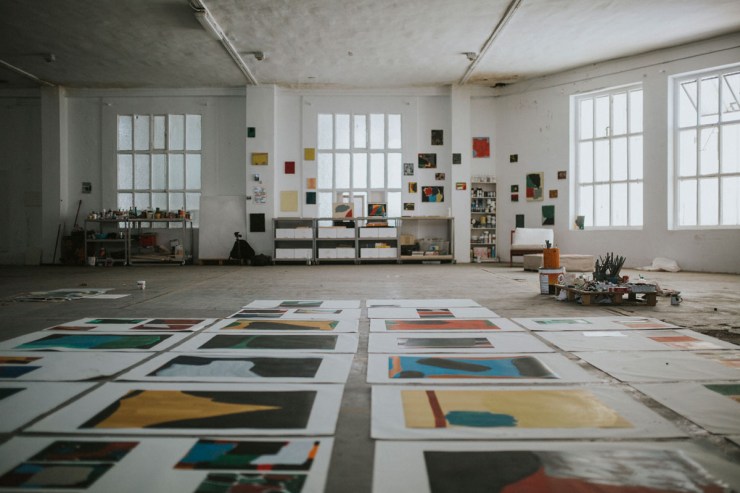
ST: Consciously, do you feel as though there is a common thread within your work?
NV: I am currently working on my new website. It is a laborious task, since throughout my career I have explored painting through different media, such as sculpture, interactive installations, video or animation. I hope to share all this content with you soon.
Organizing all of this material helps me to understand the evolution of my work as well as the connections between different periods. Thus, observing past series and projects, it could be said that the common thread of my work, beyond formal aspects, is based mainly in my interest in exploring the relationship between the individual, landscape and nature. The free use of color, references to distant and mysterious places, natural phenomena, philosophy, mythology or symbolism, are also other constants in my work.
RS: Where does your mood for work begin now?
NV: Exploring the poetry of landscape from an abstract approach remains my main objective. Nature inspires me, its physical elements and its atmosphere. But at the same time, "Cavern Fire" shows us a ludic mood and evokes aspects that relate play and construction.
NV: I am currently working on my new website. It is a laborious task, since throughout my career I have explored painting through different media, such as sculpture, interactive installations, video or animation. I hope to share all this content with you soon.
Organizing all of this material helps me to understand the evolution of my work as well as the connections between different periods. Thus, observing past series and projects, it could be said that the common thread of my work, beyond formal aspects, is based mainly in my interest in exploring the relationship between the individual, landscape and nature. The free use of color, references to distant and mysterious places, natural phenomena, philosophy, mythology or symbolism, are also other constants in my work.
RS: Where does your mood for work begin now?
NV: Exploring the poetry of landscape from an abstract approach remains my main objective. Nature inspires me, its physical elements and its atmosphere. But at the same time, "Cavern Fire" shows us a ludic mood and evokes aspects that relate play and construction.
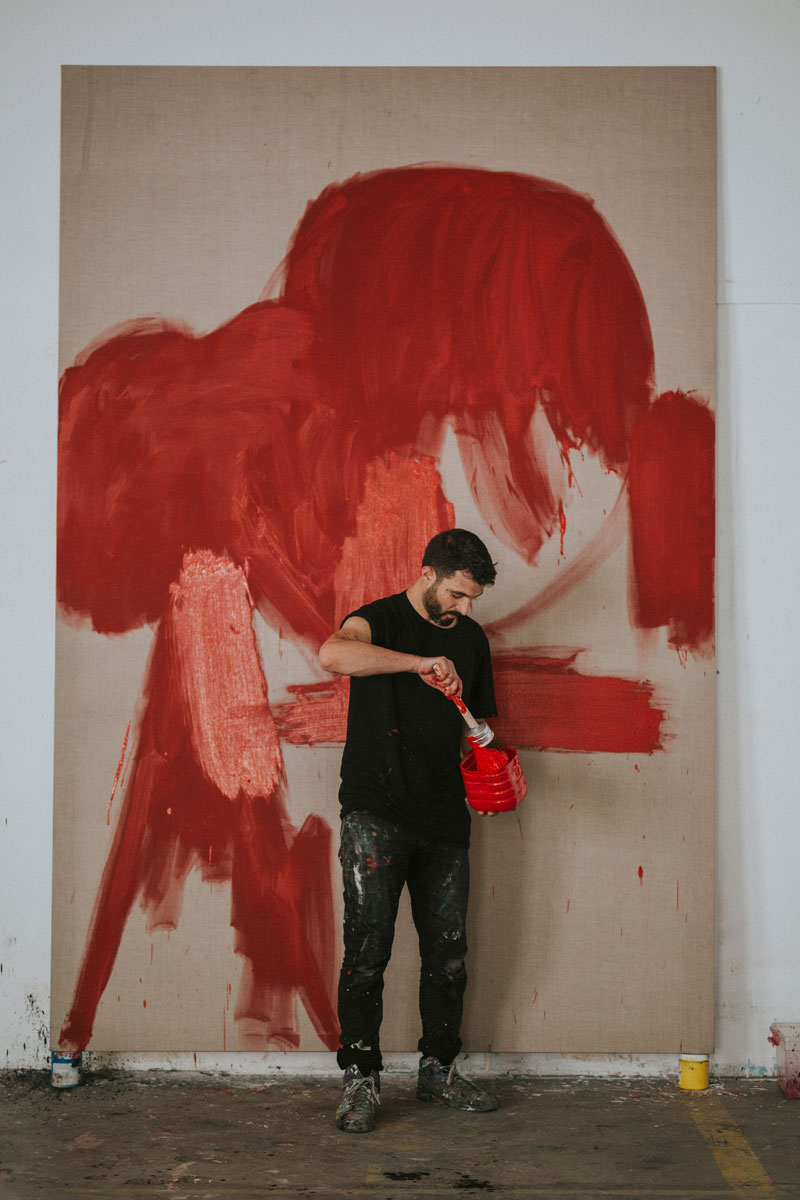
ST: Can you discuss what your eureka moment was with the mechanics of your work? Was it a brush stroke, a color, or a feeling that changed your technique to painting all together?
NV: As I said, I have worked on different projects and in each of them I have used different techniques. Usually I like to discover and use new registers in painting but for me it is important to adapt the technique to the idea. When I choose the tools, the type of paint or the support, in some way I am trying not only to determine the aesthetic aspect of the pieces, but to sub-communicate concepts, ideas or feelings. My eureka moment always comes through experimentation and it is during the painting process when I take decisions.
For example, in "Cavern Fire" I have worked mainly with oil painting on paper. This support makes it easier for me to work in an agile and intuitive way, with a spontaneous attitude, as if it were a sketch. In the same way, I can also work with a lot of material and in several pieces and formats at the same time. Furthermore, paper has specific absorption qualities and when you observe these oil paintings live, you can appreciate how they combine the strength of the brushstroke with the subtle nuances of the surface.
RS: Tell us about the series of works that are presented in CAVERN FIRE, there is some special passion in these works!
NV: Yeah, that's true. I have worked with a free and absolutely playful attitude and I am happy that this can be perceived. To me, "Cavern Fire" represents a personal reconnection with my Mediterranean roots and is inspired by the idea of "the returning to the cave", the knowledge of oneself and how lights and shadows transform our perception and moods.
At first I thought that perhaps I should be more specific and limit the forms and colors. But during the process I understood that the essence of this series lies in creating a broad register of autonomous pieces, something similar to an Atlas or a Construction Kit. So, the different structures could be used as modules and combine them to create other compositions and landscapes in future paintings.
I feel deeply that this could be the beginning of a journey and I am excited to continue exploring.
NV: As I said, I have worked on different projects and in each of them I have used different techniques. Usually I like to discover and use new registers in painting but for me it is important to adapt the technique to the idea. When I choose the tools, the type of paint or the support, in some way I am trying not only to determine the aesthetic aspect of the pieces, but to sub-communicate concepts, ideas or feelings. My eureka moment always comes through experimentation and it is during the painting process when I take decisions.
For example, in "Cavern Fire" I have worked mainly with oil painting on paper. This support makes it easier for me to work in an agile and intuitive way, with a spontaneous attitude, as if it were a sketch. In the same way, I can also work with a lot of material and in several pieces and formats at the same time. Furthermore, paper has specific absorption qualities and when you observe these oil paintings live, you can appreciate how they combine the strength of the brushstroke with the subtle nuances of the surface.
RS: Tell us about the series of works that are presented in CAVERN FIRE, there is some special passion in these works!
NV: Yeah, that's true. I have worked with a free and absolutely playful attitude and I am happy that this can be perceived. To me, "Cavern Fire" represents a personal reconnection with my Mediterranean roots and is inspired by the idea of "the returning to the cave", the knowledge of oneself and how lights and shadows transform our perception and moods.
At first I thought that perhaps I should be more specific and limit the forms and colors. But during the process I understood that the essence of this series lies in creating a broad register of autonomous pieces, something similar to an Atlas or a Construction Kit. So, the different structures could be used as modules and combine them to create other compositions and landscapes in future paintings.
I feel deeply that this could be the beginning of a journey and I am excited to continue exploring.
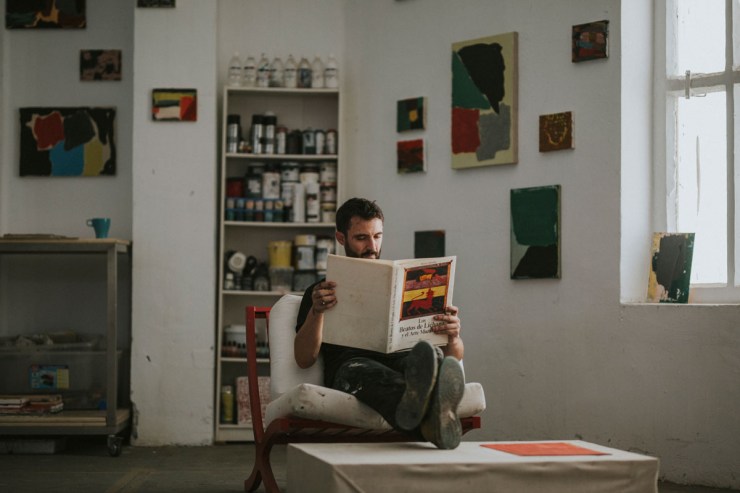
ST: When you see an artwork, what speaks to you first? The form within the work or the color?
NV: I find it interesting how in some way, our own experience and knowledge modifies the perception and therefore our taste. Over the years some of my art preferences have changed and I suppose this is because my interests and my beliefs are not static. I also think that a critical attitude is necessary but equally important as to get rid of prejudices.
That said, at first sight when I see an artwork, what speaks first to me are its plastic and aesthetic qualities. Color, form and composition are equally important to me, it's a question of balance, but above all is about harmony between appearance and substance. If, in addition, the artwork has a certain originality and a voice of its own, then it is a crush!
RS: How did you go through this difficult period of Covid 19, which so excited the whole world, did it affect you?
NV: Fortunately, my family, colleagues and friends are everyone well. In my case it was not possible for me to go to the studio, so during the quarantine period I tried to be physically and mentally active at home.
I guess for artists it has been a little easier than for the rest, as most of us are used to introspection. I confess that for me it has been a very fruitful period. I could dedicate all my time to reading, writing, watching movies and I have drawn a lot too. Luckily, I have been at my studio since a couple of months ago and I have started to work from the ideas that I developed during the confinement. I hope that little by little we could return to normality and I really wish health for all the people around the world.
NV: I find it interesting how in some way, our own experience and knowledge modifies the perception and therefore our taste. Over the years some of my art preferences have changed and I suppose this is because my interests and my beliefs are not static. I also think that a critical attitude is necessary but equally important as to get rid of prejudices.
That said, at first sight when I see an artwork, what speaks first to me are its plastic and aesthetic qualities. Color, form and composition are equally important to me, it's a question of balance, but above all is about harmony between appearance and substance. If, in addition, the artwork has a certain originality and a voice of its own, then it is a crush!
RS: How did you go through this difficult period of Covid 19, which so excited the whole world, did it affect you?
NV: Fortunately, my family, colleagues and friends are everyone well. In my case it was not possible for me to go to the studio, so during the quarantine period I tried to be physically and mentally active at home.
I guess for artists it has been a little easier than for the rest, as most of us are used to introspection. I confess that for me it has been a very fruitful period. I could dedicate all my time to reading, writing, watching movies and I have drawn a lot too. Luckily, I have been at my studio since a couple of months ago and I have started to work from the ideas that I developed during the confinement. I hope that little by little we could return to normality and I really wish health for all the people around the world.
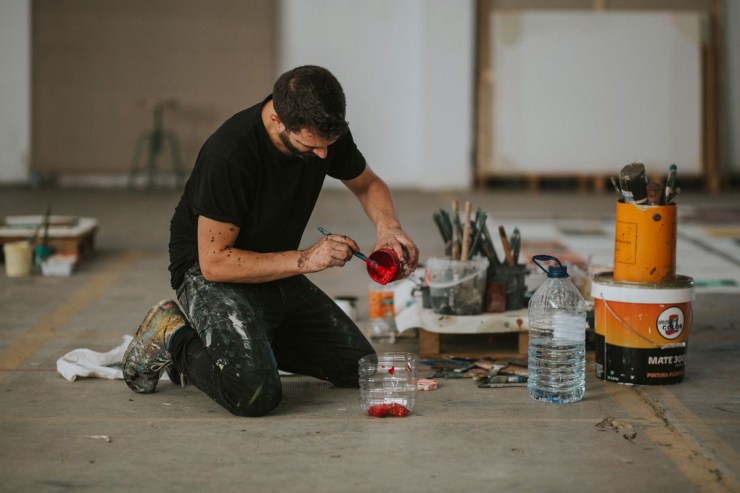
RS: We also wish everyone good health and hope these difficult times will pass as soon as possible. It had such an impact on the art world, galleries were forced to close their doors to visitors and work online, like our show "CAVERN FIRE". What do you think about art online?
NV: The worst thing about the current situation is that the public that usually could visit the galleries or art fairs, cannot appreciate the live artworks, which is undoubtedly the best way to do it. But this is only temporary, at least I hope so.
A few days ago I was talking to a gallerist about this and she explained to me how not so many years ago galleries worked without a website. This now would be unimaginable, but its appearance marked the beginning of a new form of communication with collectors and the general public. The world and the way as we consume and communicate change so fast. This proves that a continuous digital update is necessary.
The Internet, the expansion of social networks, the new visualization systems and the possibility of sharing digital contents such as audio, video or 3D simulations… allow art galleries to connect with a potential audience from worldwide. For me this is a good thing and although the unpleasant COVID-19 has forced our new way of relating with others, this situation has also allowed us to accelerate the implementation of new broadcasting systems applied to the art world, which in my opinion will be very advantageous in the future in many ways.
On the other hand, something that worries me is the information oversaturation but I think that we could avoid creating high quality art aesthetically and conceptually. The audience will know how to recognize it.
NV: The worst thing about the current situation is that the public that usually could visit the galleries or art fairs, cannot appreciate the live artworks, which is undoubtedly the best way to do it. But this is only temporary, at least I hope so.
A few days ago I was talking to a gallerist about this and she explained to me how not so many years ago galleries worked without a website. This now would be unimaginable, but its appearance marked the beginning of a new form of communication with collectors and the general public. The world and the way as we consume and communicate change so fast. This proves that a continuous digital update is necessary.
The Internet, the expansion of social networks, the new visualization systems and the possibility of sharing digital contents such as audio, video or 3D simulations… allow art galleries to connect with a potential audience from worldwide. For me this is a good thing and although the unpleasant COVID-19 has forced our new way of relating with others, this situation has also allowed us to accelerate the implementation of new broadcasting systems applied to the art world, which in my opinion will be very advantageous in the future in many ways.
On the other hand, something that worries me is the information oversaturation but I think that we could avoid creating high quality art aesthetically and conceptually. The audience will know how to recognize it.
